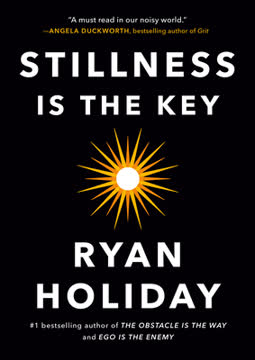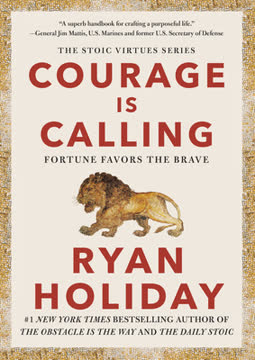Key Takeaways
1. Embrace the Dichotomy of Control: Focus on What You Can Change
"Some things are entirely up to you, while other things are not entirely up to you."
Control vs. influence. The dichotomy of control is the cornerstone of Stoic philosophy. It emphasizes that we should focus our energy on things within our control, primarily our judgments, opinions, goals, and decisions to act. Everything else, including our body, relationships, career, and wealth, is not entirely under our control.
Practical application. To implement this principle:
- When faced with a challenge, make a list of aspects you can control and those you cannot
- Direct your efforts solely towards the controllable elements
- Develop equanimity towards outcomes, as they are not fully in your power
- Remind yourself that your worth is not determined by external circumstances, but by how you respond to them
2. Reframe Your Desires and Aversions for Inner Peace
"You are not disturbed by things in themselves, but by your judgments of things."
Cognitive reframing. Stoicism teaches that our distress often comes not from events themselves, but from our interpretations of them. By changing our judgments and expectations, we can significantly reduce our suffering and increase our contentment.
Practical strategies:
- Question your initial reactions to events: "Is this truly harmful, or just inconvenient?"
- Practice negative visualization: Imagine losing what you value to appreciate it more
- Avoid labeling situations as "good" or "bad," instead see them as neutral occurrences
- Focus on the present moment rather than worrying about the future or regretting the past
- Cultivate gratitude for what you have instead of longing for what you lack
3. Cultivate Virtue as the Highest Good, Not External Possessions
"You should go through life as a traveler who stops at an inn: never regarding anything as truly yours, but as on loan from the universe."
Virtue-centric living. Stoicism posits that virtue – comprising wisdom, justice, courage, and self-control – is the only true good. External things like wealth, health, and reputation are "preferred indifferents" – nice to have but not essential for a good life.
Practical application:
- Regularly reflect on your actions: Are they aligned with virtue?
- When making decisions, prioritize moral character over material gain
- Practice voluntary discomfort to reduce attachment to luxuries
- Develop a minimalist mindset, focusing on needs rather than wants
- Measure your worth by your integrity, not your possessions or status
4. Practice Stoic Disciplines to Improve Judgment and Action
"People are distraught by losses and what they truly believe are misfortunes... What I just described are facts. The degree to which they are also horrible, or unbearable, is up to each individual's judgment."
Three disciplines. Epictetus outlined three key areas of Stoic practice:
- Discipline of Desire: Aligning our wants with nature and virtue
- Discipline of Action: Behaving justly and beneficially in society
- Discipline of Assent: Improving our judgments about impressions
Practical exercises:
- Morning meditation: Plan your day and set intentions aligned with virtue
- Evening reflection: Review your actions and judgments, noting areas for improvement
- Practice of indifference: Intentionally forgo small pleasures to build resilience
- Role-playing: Imagine how a sage would handle challenging situations
- Journaling: Write about your thoughts, actions, and progress in applying Stoic principles
5. Live According to Nature: Accept Reality and Be Pro-Social
"To live according to cosmic nature, in modern terms, just means to accept the world for what it is, as distinct from what we would like it to be."
Cosmic and human nature. The Stoic maxim "live according to nature" has two aspects:
- Accepting the reality of the cosmos as it is (following the facts)
- Embracing our nature as social, rational beings
Practical strategies:
- Study science to understand how the world truly works
- Practice acceptance of unchangeable circumstances
- Cultivate reason and logic in decision-making
- Engage in acts of kindness and social contribution
- Develop a cosmopolitan outlook, seeing all humans as part of one family
- Balance personal needs with social responsibilities
6. Update Ancient Wisdom with Modern Science and Ethics
"Nothing of substance is lost for modern Stoics if we simply identify any untenable (by modern standards) bit of ancient Stoic metaphysics and either discard it or update it by using the best science available to us."
Evolutionary philosophy. While core Stoic principles remain relevant, some aspects need updating to align with modern knowledge and ethical standards. This includes rejecting outdated metaphysics, pseudoscience, and social norms.
Key updates for modern Stoicism:
- Replace the concept of divine providence with a naturalistic worldview
- Discard practices like divination in favor of evidence-based decision-making
- Embrace gender equality and reject all forms of discrimination
- Incorporate insights from psychology and cognitive science
- Adapt role ethics to modern social structures and expectations
- Maintain flexibility, acknowledging that future updates will be necessary
7. Develop Equanimity Towards Loss and Adversity
"You should never be bewildered by appearances, and instead take a break from the situation, put some distance between yourself and the immediate impression."
Emotional resilience. Stoicism teaches us to face loss and adversity with equanimity, not by suppressing emotions, but by developing a realistic perspective on life's impermanence.
Strategies for cultivating equanimity:
- Practice premeditation of adversity: Imagine potential challenges to reduce their impact
- Adopt a long-term perspective: Consider how important current troubles will seem in years
- Focus on your response rather than the event itself
- Remind yourself of the temporary nature of all things
- Find opportunities for growth in adversity
- Use the "view from above" technique to gain perspective on your problems
8. Apply Role Ethics to Navigate Social Responsibilities
"You are a social animal, and whether you like it or not, living in a society comes with certain duties."
Balancing roles. Stoic role ethics helps us navigate the various responsibilities we have in society, from personal relationships to professional duties and civic obligations.
Applying role ethics:
- Identify your various roles: family member, friend, professional, citizen, etc.
- Reflect on the duties and expectations associated with each role
- Prioritize roles based on their importance and ethical considerations
- Strive to fulfill your roles virtuously, regardless of how others behave
- Use conflicts between roles as opportunities for ethical reflection
- Regularly reassess and adjust your approach to different roles
9. Engage in Continuous Self-Improvement and Philosophical Practice
"Why are you still waiting to be the best that you can be? You have heard the message, you have understood it, and you have agreed with it. So, what's stopping you from putting it into practice?"
Lifelong learning. Stoicism is not just a set of ideas, but a practice to be implemented daily for continuous self-improvement.
Practical steps for ongoing growth:
- Establish a daily routine of Stoic exercises (e.g., morning meditation, evening review)
- Read Stoic texts regularly, reflecting on how to apply their wisdom
- Seek out a community of fellow practitioners for support and discussion
- Set specific, measurable goals for applying Stoic principles in your life
- Regularly assess your progress and adjust your practice
- Be patient with yourself, recognizing that change takes time
- Share your insights with others, as teaching reinforces learning
Last updated:
Review Summary
A Field Guide to a Happy Life is a modern interpretation of Stoic philosophy, particularly Epictetus' teachings. Readers appreciate Pigliucci's updated examples and language, making ancient wisdom more accessible. The book offers practical lessons on focusing on what one can control and cultivating inner peace. While some find it repetitive or oversimplified, others value its concise approach to Stoicism. Critics note the author's materialistic perspective and removal of metaphysical elements, but overall, it serves as a useful introduction to Stoic principles for contemporary readers.
Similar Books










Download PDF
Download EPUB
.epub digital book format is ideal for reading ebooks on phones, tablets, and e-readers.










